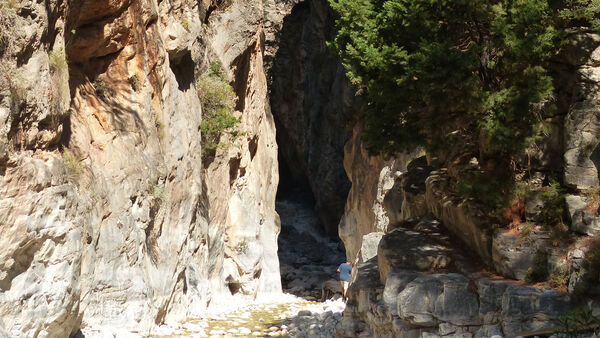Crete’s Samaria Gorge
By Rick Steves
Swarms of tourists flock to the Greek island of Crete. Many leave, disappointed by the crowds. Try to avoid peak season and the crowded cities. Hike through the rugged interior instead and find a remote corner of the south coast. While ridiculously congested in the height of summer, the 10-mile hike through the Gorge of Samaria can be a Cretan highlight.
Your home base for this loop trip is Hania, a city on Crete's north coast serviced frequently by the overnight boat from Athens. Catch the earliest bus from Hania to Xyloskalo to beat the heat and midday crowds. After a scenic 25-mile bus ride, you'll be standing high above the wild Gorge of Samaria. Xyloskalo is a small lodge, the end of the road, and the beginning of the trail. The bus will be full of hikers; no one else would come here at this hour. The air is crisp, the fresh blue sky is cool, and most of the gorge has yet to see the sun. Before you lies a 10-mile downhill trek, dropping 5,000 feet through some of the most spectacular scenery anywhere in Greece to a black-sand beach on the south coast.
Descend to the floor of the gorge down an hour of steep switchbacks, where you'll reach the stream, a great place for your picnic brunch. A leisurely meal here will bolster your energy, lighten your load, and bring you peace, as this break will let most of the other hikers get ahead of you. If the crowds just won't let up, find solitude by following a stream up a side gorge.
Between you and the Libyan Sea on Crete's southern shore are about eight miles of gently sloping downhill trails. Hiking along the cool creek, you'll pass an occasional deserted farmhouse, lazy goats, and a small ghost town with a well. In the middle of the hike, you'll come to the narrowest (and most photographed) point in the gorge, where only three yards separate the 1,000-foot-high cliffs. Keep your eyes peeled for the nimble, cliff-climbing agrimi, the wild Cretan mountain goats.
Finally, by midafternoon, signs of Greek civilization begin peeking through the bushes. An oleander chorus cheers you along the last leg of your hike to the coast. You'll find a tiny community with a small restaurant and a few cheap places to stay. The town, Agia Roumeli, is accessible only by foot or boat. Three to six times a day, a small boat picks up the hikers and ferries them to Chora Sfakion (last ride is usually around 6:00 p.m.). Before you begin your hike, confirm when the last boat leaves so you can pace yourself.
While you're waiting for the boat (after you buy your ticket), take a dip in the bathtub-warm, crystal-clear waters of the Libyan Sea. Africa is out there somewhere. The black-sand beach absorbs the heat, so wear your shoes right to the water's edge. A free shower is available on the beach.
The hour-long boat ride (or eight-hour hike) to Chora Sfakion passes some of Crete's best beaches and stops briefly at the pleasant fishing village of Loutro (with several pensions). Buses meet each boat at Chora Sfakion to return you to Hania. The untouristy village of Paleohora (west of Agia Roumeli) has great beaches and a bus connection to Hania. In crossing the island of Crete, the bus goes through some dramatic scenery and several untouched villages inhabited by high-booted, long-mustachioed, espresso-drinking Cretans.


